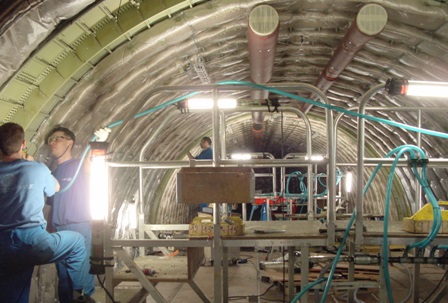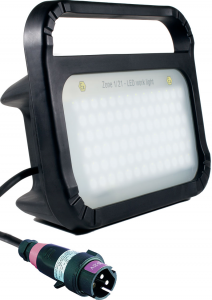The differences between portable and

A typical fixed luminary.
The Key Differences Between Fixed and Portable Lights.
There is a significant difference in both the application and construction of fixed lights compared to portable work lights. On the market most ATEX lights are so called fixed lights, luminaries, but the differences with our portable solutions are big.
Fixed Lights
Fixed lights are permanently installed and typically found on walls, lampposts, or ceilings. They are designed to provide lighting in a specific area without the need for relocation.
Portable Lights
Portable lights are essential tools for tasks that require mobility, such as repairs, maintenance, or inspections. Different situations call for different types of portable lighting—flashlights are ideal for quickly inspecting small areas, while floodlights or work lights are used to light up larger spaces, mostly for lengthy interventions. Important difference: the need for illumination on that specific spot is temporary only. Job done and the tools, including the construction lights can be removed, hence the name temporary work lights.
Key Differences Between Fixed and Portable Lights
1. Mechanical Durability
Fixed lights, whether mounted on lampposts, walls, or ceilings, are subject to lower mechanical demands. These lights do not need to withstand drops, impacts, or the wear and tear associated with regular handling. In contrast, portable work lights must be durable enough to endure rough handling, making mechanical strength a critical factor in their design. See here for our first shockproof test. Additionally, the weight of portable lights is a key consideration since they need to be easily transportable.
2. Protection Against Static Electricity
ATEX portable lights require safeguards against the build-up of static electricity, a potentially hazardous condition that could lead to sparking. For instance, friction against clothing during movement can generate static. To mitigate this risk, portable lights with metal housings include a third core in the power cable to discharge static build-up, while plastic housings must be made of anti-static materials. It’s important that these anti-static properties are long-lasting, even after exposure to impacts or cleaning. A simple coating, like the one found on polycarbonate, may not be sufficient. If using a plastic housing with a sprayed anti-static film, regular testing of its anti-static properties is advisable. Tools like the Testeur can be used for this purpose.
Our Ultra2/XL and Ultra3 floodlights feature housings with fully integrated anti-static properties that resist deterioration from scratching, cleaning, or impacts.
3. Weight Considerations
Although there are no specific ATEX regulatory requirements concerning the weight of portable lights, national regulations related to working conditions may apply. The Ultra2, for example, is equipped with a high-capacity battery, comparable to a medium-sized car battery over 50Ah. Despite this, the Ultra2 and UltraXL have been engineered to weigh only approx 6 kg – the only floodlights that are floating, making it! – highly portable without compromising performance.
Temporary and Portable Work Lighting for Construction
During various industrial activities, there may be a need for temporary lighting solutions. This is common during the construction or maintenance of ships, the repair of machinery or aircraft, or maintenance shutdowns in the process industry or oil processing. In such cases, portable explosion-proof floodlights are essential.
When working on large surface areas, such as between petrochemical installations, area lighting like light towers or mobile light towers provides an effective solution. For more localized illumination, portable or movable work lights are the most practical option. Our extensive range of portable work lights is designed to meet the needs of industrial professionals. Whether you require a small, rechargeable Ultra work light for inspections or a large work lamp for surface and room lighting in tanks, our solutions are easy to transport and simple to use.
Please Note: Our ATEX products are designed for professionals and industrial applications, not for consumer use.

Temporary led work lighting for construction
During various industrial activities, it may happen that flood lights are only needed temporarily. For example, during the construction or maintenance of ships. Also, temporary worklights are needed during the repair of machines or aircrafts. Or maybe you are working in maintenance or cleaning stops in the process industry? Either way, portable (explosion proof) flood lights are needed!
Temporary construction lighting led
When it concerns a project at a location with a large surface, like between petrochemical installations, area lighting such as light towers or mobile light towers is a good solution. If more local light is needed, portable or movable work lighting is the most common. You will find a wide selection of portable work lighting on our site. Our program includes lamps from small to large. For example, there is an rechargeable Ultra work light for inspection work, the largest is a work lamp for surface and room lighting in, for example, tanks. Our solutions are to transport and easy to use.
Please note: we focus on the professionals, we offer solutions for the industry, not for the consumer.
What are the characteristics of good portable work lighting?
•Ease of use: lightweight and compact in construction, good to position, to hang or put down.
• Operating time, if rechargeable, should match the duration of the work.
•The housing must not become hot (fire hazard), in the event of breakage, no dangerous situation may arise.
•The light emitted should resemble white sunlight as much as possible.
•The lamp should be energy efficient.
•When colliding the lamp nor the object it collides into should be damaged.
•Maintenance must be easy to carry out, of course electrical safety is also important.
Please have a look at work lights that meet the criteria: the UltraXL and the Ultra3.
